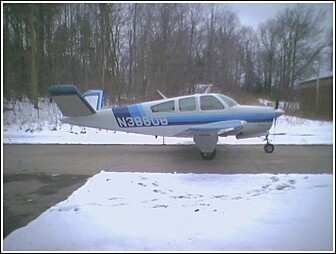Aircraft Broke Up In Flight, According To The Report
The NTSB has released a preliminary report from an accident May 3 involving a Beech V35B, N440H, operated by a private individual, which was destroyed during an in-flight breakup and collision with terrain near Syosset, New York.

The certificated airline transport pilot and two passengers were fatally injured. The personal flight was conducted under the provisions of 14 Code of Federal Regulations Part 91. Instrument meteorological conditions (IMC) prevailed and an instrument flight rules flight plan was filed for the planned flight to Robertson Field (4B8), Plainville, Connecticut. The flight originated from Grand Strand Airport (CRE), North Myrtle Beach, South Carolina, about 1240.
According to preliminary air traffic control (ATC) information provided by the Federal Aviation Administration (FAA), the pilot was in radio contact with ATC about 1530 and the airplane was level at 7,000 feet. At that time, the pilot reported to the controller that the airplane had experienced a failure of the vacuum system and associated gyroscopic instruments. The pilot added that the flight was currently operating in visual flight rules (VFR) on top of clouds and he planned to continue VFR to his destination airport. Subsequently, the airplane re-entered IMC and the pilot reported losing control of the airplane in addition to losing more instrument functionality. Radio and radar contact was lost with the airplane at 1542.
The wreckage impacted a populated area consisting of residences, fields and wooded terrain. A debris path extended approximately .4 miles on a magnetic course about 010 degrees. The outboard section of the right ruddervator, remaining right ruddervator, and sections of the interior overhead panel were located at the beginning of the debris path. The fuselage, outboard section of the left wing, left ruddervator and right wing were located about 400 feet further along the debris path. The inboard left wing was located about another 400 feet further and the engine and instrument panel were located at the end of the debris path.

The outboard left wing separated near the aileron/flap junction and exhibited paint transfer consistent with right ruddervator contact. The left aileron separated and fractured into two sections. The left inboard wing remained attached to the carry-through spar and the spar caps displayed deformation damage in an upward direction. The left flap remained attached to the inboard left wing section. The right wing separated near the root and approximately 8 gallons of fuel remained in the right wing. The right flap remained attached to the right wing along with an approximate 15-inch section of inboard right aileron. The right ruddervator separated and the left ruddervator remained attached to the tailcone. Measurement of the elevator trim jackscrew corresponded to an approximate 10-degree tab up (nose down) trim setting. Due to multiple separations and cabin fragmentation, flight control continuity could not be verified; however, all recovered flight control cables exhibited broomstraw separation,
consistent with overstress.
The propeller separated from the engine at crankcase and the engine came to rest inverted, buried in a 3-foot crater. One propeller blade had separated from the hub while the other two propeller blades remained attached. All three propeller blades exhibited scoring and bending. The crankshaft could not be rotated due to front engine case damage; however, borescope inspection of all six cylinders did not reveal any preimpact mechanical malfunctions. Both magnetos sustained impact damage and could not be tested. The top spark plugs were removed from the Nos. 1, 3, and 5 cylinders for examination, and the bottom spark plugs were removed from the Nos. 2, 4, and 6 cylinders for examination. Their electrodes were intact and light gray in color. The engine driven fuel pump remained attached and its drive coupling was intact. When the drive coupling was rotated by hand, the engine driven fuel pump shaft rotated. The fuel metering unit and manifold valve also sustained impact damage.
The vacuum pump remained attached to the engine and was retained for examination at the NTSB Materials Laboratory. A panel-mounted GPS was removed from the instrument panel and also retained for data download at the NTSB Recorders Laboratory.
The pilot held an airline transport pilot certificate with a rating for airplane multiengine land. He also held a commercial pilot certificate with a rating for airplane single-engine land. His most recent FAA third-class medical certificate was issued on September 3, 2014. At that time, he reported a total flight experience of 4,000 hours.
The six-seat, low-wing, retractable tricycle-gear airplane, serial number D-9464, was manufactured in 1973. It was powered by a Continental IO-520, 285-horsepower engine, equipped with a three-blade constant-speed McCauley propeller.
(Image from file. Not accident airplane)
 ANN's Daily Aero-Term (04.25.24): Airport Rotating Beacon
ANN's Daily Aero-Term (04.25.24): Airport Rotating Beacon ANN's Daily Aero-Linx (04.25.24)
ANN's Daily Aero-Linx (04.25.24) Klyde Morris (04.22.24)
Klyde Morris (04.22.24) Airborne 04.24.24: INTEGRAL E, Elixir USA, M700 RVSM
Airborne 04.24.24: INTEGRAL E, Elixir USA, M700 RVSM Airborne 04.22.24: Rotor X Worsens, Airport Fees 4 FNB?, USMC Drone Pilot
Airborne 04.22.24: Rotor X Worsens, Airport Fees 4 FNB?, USMC Drone Pilot




